The Future of Dhaka's Urban Transportation
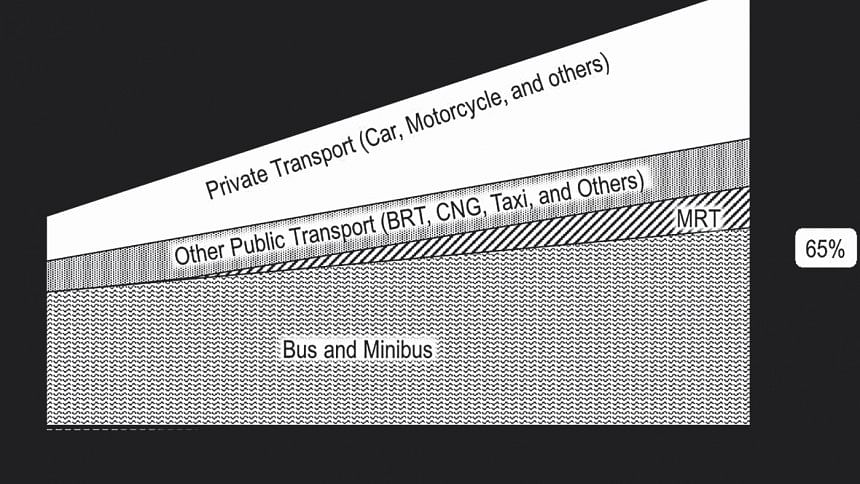
In a fast growing mega city like Dhaka, the purpose of designing a strategic transport plan is to provide a structural framework for the total urban transportation needs for the future, from which segmental parts may be implemented in phases. Priorities and time frames as well as expected gross budgets are also stated. Further, in each segment, the impact of the programme including the volume and the capacity of commuters it can carry is also indicated in gross terms. Since 2004 Dhaka has had two major strategic transport plans passed. First, it was the Strategic Transport Plan (STP) Dhaka 2004-2024, prepared by Louis Berger Inc., an independent consultant, and BCL, a local consultant. It had a consultative advisory committee, called The STP Advisory Committee, comprising of all local experts. It had also provisions for a review every five years and upgrades. The government decided to revise the STP in 2014-2015 and extend its time frame to 2035. In this article I have taken the liberty of assessing some of the potential impacts of the RSTP (Revised Strategic Transport Plan) 2015-2035 on Dhaka's urban transportation.
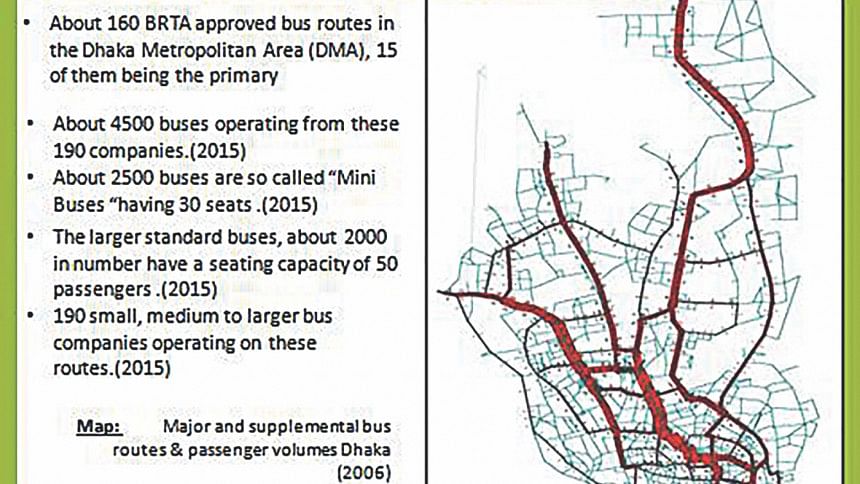
In short order, the original plan (2004-2024) had six major components: 1) A pedestrian first policy; 2) Developing and upgrading regional roads; 3) A Roads ++ programme of 54 new roads and three expressways; 4) A three line BRT (Bus Rapid Transit) development (BRT Line 1, 2 and 3); 5) Three lines of the Metro lines (lines 4, 5, and 6); 6) Development of surrounding water ways for river travel. The STP was approved in 2009.
The RSTP (2016-2035), was prepared by JICA and approved by GOB in 2016. It had no local public overseeing committee. The RSTP, while endorsing most of the STP programmes, extended some of them. A two layer arterial circular roads programme surrounding Dhaka was added. The number of BRT programmes was reduced from three to only two. The MRT (Metro) lines programme was massively extended and increased from three lines to five lines. While it was published and circulated, no component of this plan was reviewed adequately in public during the process of developing the plan. Priorities given to the Metro programme was of much higher order than other programmes. What will be the impact of this new JICA proposed and designed RSTP (2016-2035)?
The above data graph by JICA in RSTP (2015-2035) shows a growing urban commuter demand in greater Dhaka (DMP+) urban region to 2035. In 2016, the travel demands were approx. 21 million commuters per day. Of these 45 percent or nearly nine million people including pedestrians used the non-motorised modes of travel. The balance was carried out by motorised transports, largely by the present fractionised and archaic bus system. In addition, Dhaka is also served by inter-district bus systems. These buses enter Dhaka mainly by three major entry/exit points, namely Gabtali, Saidabad and Mohakhali.
Of these, Mohakhali, situated in the heart of the city, causes most problems, coming deep into the city and causing increasing traffic congestions. Nearly 10,000 buses enter and stay in the city from these inter-city terminals, in addition to the existing traffic. Any future solution to this particular problem would require the shifting of these bus terminals to the northern end of the present city, possibly beyond Tongi.
The population of Dhaka growing at an average of 3.8 percent to 4.0 percent per year will add 500,000 to 600,000 to the existing population every year. As per STP and RSTP reports, the population of greater Dhaka will be around 38,000,000 (38 million) by 2035. This will generate a commuter demand of 61 million to 65 million per day. Of these numbers, 45 percent could be by various modes of pedestrian and non-motorised transports. That will still require about 35 million to travel by various motorised transports.
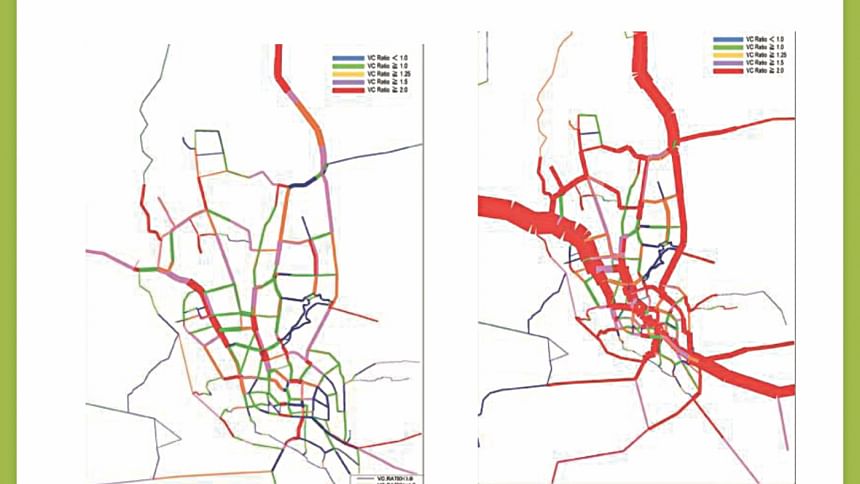
Please see the bus routes and traffic volumes as per STP (2004-2024) in Dhaka City in 2006 (Fig 02) and corresponding travels in 2014 (F ig 03) and projected in 2035 (Fig 03) by RSTP. As noted earlier the motorised commuter demand in 2035 will be around 35 million trips per day. RSTP (2016-2035) report prepared by JICA presents a very important graph chart (Fig 01). This shows the expected volumes to be carried by different modes of motorised transports: 1) The private vehicles (cars, motor cycles and others) will grow very largely; 2) The other public transports (BRT, CNG, taxis and others) will not be able to grow much from its present capacity; 3) The next item is JICA proposed five or more Metro lines, which will grow from zero in 2019 to five lines in 2035, carrying marginal volumes in capacity within the total motorised transport system; 4) The bus and the mini buses are expected to carry the remaining 45 percent or more of the total new transport commuting demands.
Five Proposed Metro Lines
In order to achieve its 2035 goals, JICA proposes to build a minimum of five Metro lines in DMP area. Metro Line 6 from Uttara North to Motijheel and Kamlapur Station is now in advanced stage of construction. This Metro line is above grade (elevated) and is expected to be finished in 2021 according to sources. The project is to cost about $2.8 billion (or Tk. 22,000 crores). The announced passenger carrying capacity is said to be 60,000 passengers per hour. In my opinion, no more than 42,000 is possible, given a train will have six compartments and a maximum capacity of 1,400 passengers per train and a frequency of every four minutes from both directions, i.e. 140 x 15 trains x two way = 42,000 persons per hour max. Four other Metro lines are also proposed for development during this period (2019-2035). These are Metro Line 1, from Airport to Saidabad via Kamlapur Train station, plus a connection from Purbachal (RAJUK town) to Kuril junction of main line. This will be largely underground with some parts elevated. The cost of this Metro line announced is approx. Tk. 90,000 crores or $10.5 billion. The other two lines are Metro line 2 from Savar to Gabtali and Farmgate (mostly elevated) and Metro lines 5, south and north (partly elevated and partly underground). The sum total cost of these five lines according to JICA and RSTP will be nearer Tk. 200,000 crores (or $24 billion approx.). These five lines when completed will carry a maximum of 3.4 million commuters per day by best accounts. While this is a large amount, it will be about only eight percent of the total commuter trip demands or 12 percent of the total motorised commuter volume requirements.
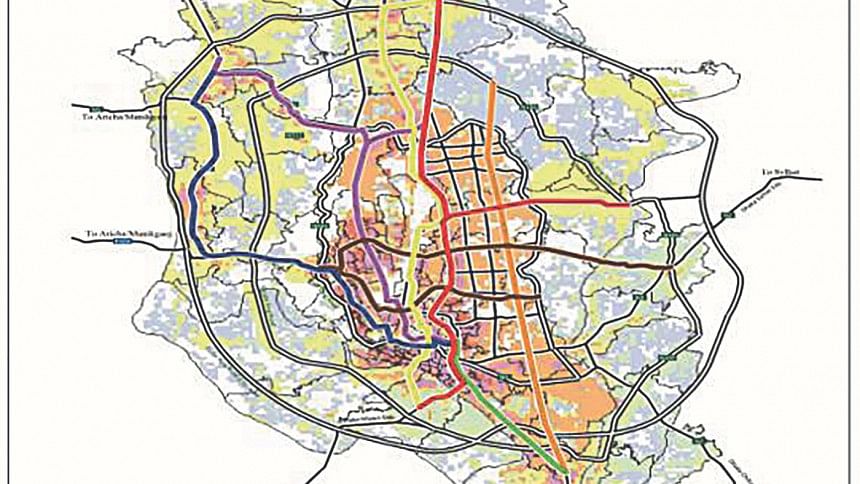
Roads++ and Bus System
The RSTP documents also propose a series of roads programme, including all of STP Roads++ programme and two layers of circular roads. An improvement of the existing bus system is also proposed. However, the Metro system gets the priority. The roads programme and the new bus system are yet to get started. If these projects are undertaken in rapid succession and if all roads proposed by the STP and the RSTP documents are built within the next ten years (2030), it will be able to carry all the traffic projected in the RSTP diagram (Fig 01) at a fraction of the cost of the five Metro lines. The entire Roads++ programme and the total bus system can handle in excess of 20 million bus commuters, and all other necessary motorised traffic volumes, while we propose further additions. I can suggest with an allocation of half the total amount of the Metro lines, we can build the total Roads++ and the bus system of 17,000 buses for less than $12 billion. The bus sector will primarily be operated by private sector with government regulations and monitoring. The total commuter carrying capacity of these projects will be five to six times that of all metros combined at less than half the cost and could be achieved much earlier. It will be money better spent with far greater benefits. Each Metro, which is donor dependent and developed at their pace of lending, is also very capital intensive and each line needs a time frame of at least ten years from planning to completion. I am not suggesting we abandon further Metro development, just slow its development and use the resources in the roads and bus system where it will do the most good in the near future. There is a place for both in Dhaka's future urban transportation.
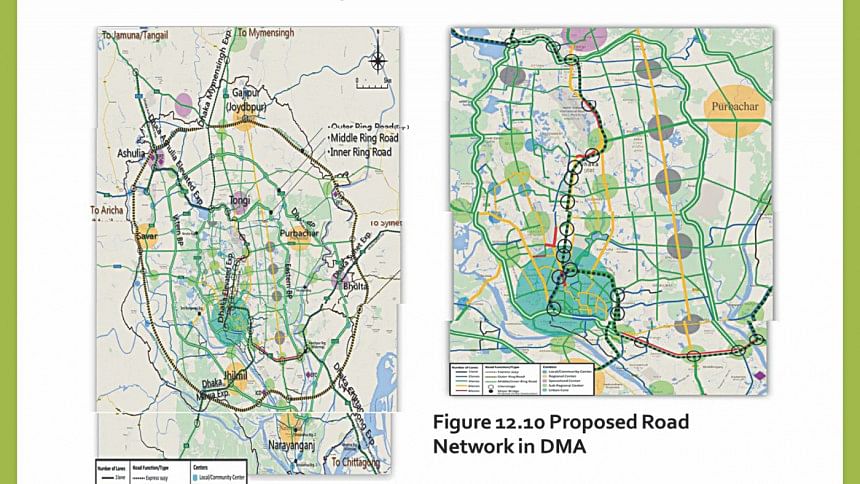
Architect Tanwir Nawaz is a Rockefeller 3rd Fund Scholar, Chairman of Urban Habitat Consultants and a Member of Advisory Committee of STP (Strategic Transport Plan) Dhaka (2004-2024). He was also Senior Consultant to DTCB in 2010-2011 and prepared DTCA and DMTCL (Dhaka Mass Transit Company Ltd.) organograms and relationship structures and the route realignment proposal for Metro Line 6 from Shahbag to Bangladesh Bank.

 For all latest news, follow The Daily Star's Google News channel.
For all latest news, follow The Daily Star's Google News channel. 


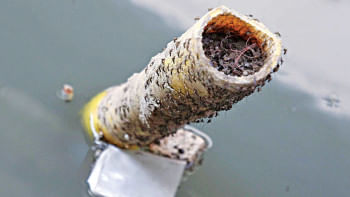
Comments